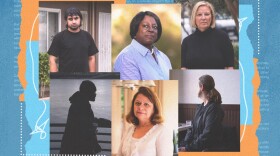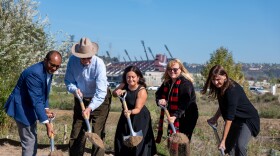The clock was ticking when Angie Bedoya held up a pair of inside-out jeans to five judges, exposing the different sizes of each pocket. She pushed her phone deep into the left pocket — almost down to the knee — as her business partner, Emely Rodriguez, dramatized in American Sign Language, "Look at these big, glorious pockets!"
At Gallaudet University's recent Bison Tank contest in Washington, D.C. — a college version of the popular TV show Shark Tank — the two students pitched a pocket-tailoring company called "Super Pockets," in hopes of joining the growing ranks of deaf business owners nationwide.
Faced with widespread, chronic unemployment but also improvements in technology that enable better communication, deaf people are creating their own businesses and pushing employers to become more deaf and sign language friendly.
In Maryland alone, there are now more than 75 deaf-owned businesses. Kelby Brick, who is director of the Governor's Office of the Deaf and Hard of Hearing, says this "deaf ecosystem" is growing rapidly, economically empowering deaf and hard of hearing individuals. Deaf-owned businesses are popping up nationwide, too — including Mozzeria, a California pizza restaurant; Deaf Friendly, a Yelp-like platform that can tell you where to find bartenders who sign or places that play the music loud enough; or DeafTax.com, which provides tax preparation services in American Sign Language.
These deaf-owned businesses often hire other deaf people, helping to grow a sort of deaf economy. Owning a business also improves confidence and social skills among deaf people, says Ryan Maliszewski, director of the Gallaudet Innovation & Entrepreneurship Institute.
"Deaf people need to improve their soft skills of leadership, collaboration, confidence and teamwork," he said. "My goal isn't just to help them develop a business to make money but really to develop their soft skills."
Deaf-owned brewery debuts
One of the newest deaf businesses in Maryland is Streetcar 82, a Hyattsville brewery co-owned by three deaf men.
On the front of the crisp, white building hangs a sign with a logo featuring a green streetcar. The logo is also plastered on workers' apparel. Both were made by other deaf-owned businesses. Like many deaf-owned businesses, the owners at Streetcar 82 said they try to prioritize deaf sources for any contract work.
Most of the repair and material workers they hire are deaf. All of their staff is deaf.
The idea for the brewery originally came to co-founder Mark Burke after two years on the job hunt.
Burke had worked in the education field, as an athletic director at the Model Secondary School for the Deaf. He applied for hundreds of education jobs, but got only two interviews. He received no offers.
During this time, Burke earned cash by bartending and made beer at home for fun. Making beer was just something Burke saw as a hobby until one day, a friend suggested that he open a brewery to sell his beer.
The suggestion came in June 2016, one week before Gallaudet University's first-ever Bison Tank contest. Burke recruited two interested friends to throw together a business pitch. Though they didn't win the competition, they won the most votes, earning them a crowd favorite prize of $250. They never looked back.
Two years later, the brewery became a reality.
"My goal is to make the best beer," Burke said. "But the impact and magnitude of how this influences the deaf community is inspiring."
Though starting the brewery took a lot of hard work, Burke said it was easier than it would have been in years past. Burke credits technology improvements as the reason he was able to research how to start a business.
"Twenty-five years ago, deaf-owned businesses were not a thing because the resources were not there," Burke said.
Technology such as video relay service (VRS), a video-based interpreting call service, made it easier for the company to communicate with the Small Business Administration and get a loan, he said.
And though all the staff is deaf, Streetcar 82 also has a phone number — another added benefit of VRS. With technology like that, Streetcar 82 is catering to both deaf and hearing customers, Burke said, bridging the gap between what are sometimes thought of as separate worlds.
Left out of the "hearing world"
In the so-called "hearing world," many deaf people NPR spoke with say they feel left out — and for individuals who were mainstreamed, it's an experience that often mirrors their childhood. Chris Soukup, the CEO of Communication Service for the Deaf (CSD), says this is detrimental for their career development.
"People who come to us from corporate jobs have often worked in isolation, in a box all the time closed off from opportunities for promotion," Soukup said. "They don't have the same social opportunities and experiences at the corporate hearing world."
Knowing this, Gallaudet junior Meghan Hatfield has concerns about working in the "hearing world." Hatfield is a friendly, unassuming redhead from Eagan, Minn., with a strong deaf identity. Both of her parents are deaf. Her mom works in the "deaf world" — at a deaf school. Her dad works in the "hearing world" — at a post office.
Watching her father struggle to find a job in the "hearing world" gave Hatfield a desire to work for a deaf-owned business, where she knows she will not be overlooked for her disability.
"Hearing companies lay off people like us," she said. "I can do a lot of things, but I feel there's a barrier."
Though she is a communications major, Hatfield said she lacks confidence when trying to communicate with hearing people.
Fostering communication between the deaf and hearing is exactly what Soukup and his company are trying to do. A towering man with a self-assured voice and steady signing hands, Soukup has been fighting against the perception of deaf people as "lesser" his whole life. His company, CSD, firmly believes that the only way this misconception will change is through a larger conversation.
Bridging the deaf and hearing worlds
Established companies are increasingly making efforts to accommodate, include and support deaf employees and customers. CSD preaches the idea of "One World," where deaf and hearing alike can come together. This world became a reality in one new coffee shop.
Starbucks' first store run entirely in ASL opened this fall. On the day of the grand opening, the line for coffee stretched back past a deaf artist's colorful cubist mural to the front door, where ASL letters spelled out S-T-A-R-B-U-C-K-S.
Deaf and hearing customers alike ordered at the register. Non-ASL-using customers used touchpads or wrote their orders. But those who knew ASL simply had to rub one fist over the other in a circular motion, mimicking manual coffee grinding — the sign for "coffee."
At many of the tables, customers stole sips of coffee whenever their hands weren't flying rapidly in conversation. Television news crews came to cover the grand opening and trained their cameras on a discussion between Hatfield and some fellow students.
Hatfield held her palms parallel to the floor, bent both her ring fingers downward and bobbed them up and down — the sign for "awkward."
She was agreeing with her friends that it felt like they were being watched by hearing spectators. The cameras kept rolling, oblivious to her words.
Despite the zoolike atmosphere, Hatfield said she was excited about the Starbucks. Many of her friends were, too.
"I know a lot of deaf people who want to apply here, but they only have a few jobs open," she said.
All of the staff members at this Starbucks location are fluent in ASL. Some are deaf, including store manager Matthew Gilsbach.
Prior to this job, Gilsbach was used to feeling alone in the hearing world. He grew up in Michigan, where he went to a mainstream school but felt left out by his peers. He then got a bachelor's in communication studies from Gallaudet and a master's in higher education supervision from the University of Vermont.
After getting his master's, he started looking for a job in his field but wasn't having any luck. He decided to work at Starbucks in the meantime.
"I need to find a company that's willing to take a risk. I've been met with 'is this going to require an interpreter? This is going to cost money,' " Gilsbach said of his job-hunting experience. "Starbucks was willing to take that risk."
At first, Gilsbach worked in a store in California, but when he found out about plans to open an ASL Starbucks, he knew it was a perfect opportunity for him. In his new role, Gilsbach now enjoys full accessibility, and he said he really feels like he is a part of the team.
Not waiting for "change to rain from the sky"
Rather than creating their own "deaf ecosystems," some deaf employees and organizations are pushing employers and their industries for better accommodations. Some jobs — like driving a passenger bus, screening for TSA and flying commercial planes — still require hearing ability. But deaf employees say those requirements are, in some cases, based on outdated stereotypes, not the actual ability to do the job.
Deaf pilot Jackson Busenbark is only allowed to fly small, private airplanes. He doesn't have a first class medical certificate, required by the Federal Aviation Administration to fly larger jets and make a living as an airline pilot. Under FAA regulations, he can't get one because larger airports and airlines rely on radio communication.
However, Busenbark and other pilots in the Deaf Pilots Association, numbering over 200, argue that the FAA's multibillion-dollar effort to modernize U.S. airspace, dubbed NextGen, will eliminate the need for radio communication. Under NextGen, flights will be satellite and GPS based, using data communication such as texting to supplement voice communication.
Busenbark was featured in CSD's "Let Us Work" campaign, showcasing deaf individuals who would be able to perform jobs that they are barred from doing.
Texting would actually be safer than voice communication, especially as flights grow increasingly global and numerous, Busenbark believes.
"Radio communication has its disadvantages. People tend to have misunderstandings all the time," he said. "Accents can be a problem for communication, and when two pilots try to contact the tower at the same time, it messes with the transmission, so critical information can be misheard, resulting in death."
Despite NextGen changes in technology, an FAA spokesperson said that there will still be a hearing requirement for a first class medical certificate.
"Some voice could be necessary as a backup," the spokesperson said in an emailed statement. "Currently, the technology to allow a deaf pilot to fly safely as an air transport pilot does not exist."
Busenbark disagrees. He said the problem is not a lack of technology, but rather what he called the FAA's culture and stigma against the deaf.
"There's a paternalistic view of deaf people where they think that because deaf people can't hear, it's dangerous," he said. "But there's this thing called deaf gain — a concept that deaf people have an advantage that hearing people don't. For example, studies show that we have a better response time to visual stimuli."
CSD used the idea of "deaf gain" to launch its #DeafEffect campaign, where it invited deaf workers to share stories of times their hearing loss was advantageous.
Soukup hopes these campaigns change the social perception of deaf people, but he said he understands it takes time. In the meantime, CSD also runs a Social Venture Fund, which provides deaf-owned businesses with money and support.
"We've adopted this mindset of fighting by land, by sea, by air," Soukup said. "Rather than waiting for change to rain from the sky, it's about creating changes with deaf businesses."
He added that CSD's work will be done only when it's common to see successful, employed deaf people.
"I'm most surprised when there are success stories, and that's the opposite of what it should be," Soukup said.
When asked how long he thought it would take for deaf people to be equally employed, it was the only time Soukup was truly speechless.
Copyright 2019 NPR. To see more, visit https://www.npr.org.






